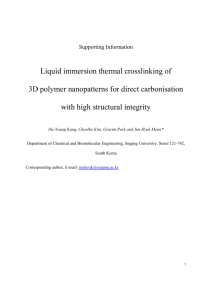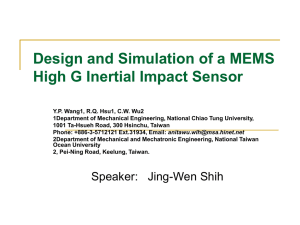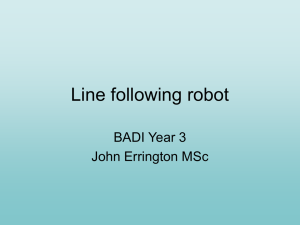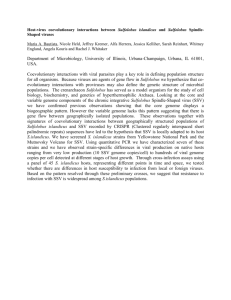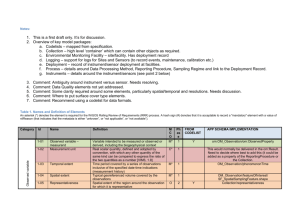Sensors
advertisement
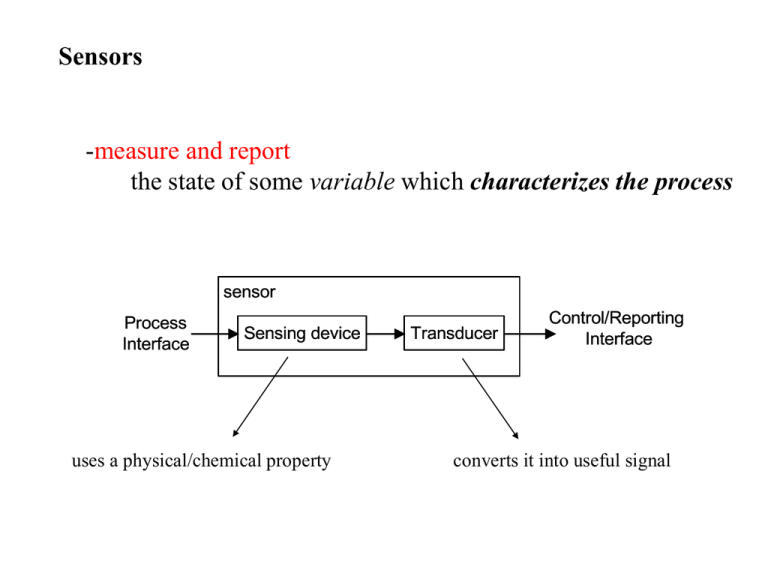
Sensors -measure and report the state of some variable which characterizes the process sensor Process Interface Sensing device uses a physical/chemical property Transducer Control/Reporting Interface converts it into useful signal Temperature physical property used? mercury thermometers thermoelements RTD (resistance temperature detector) ?? Seebeck effect: emf in a circuit connecting elements maintained at different temp resistors: dR/dT != 0 platinum: linear over large range Thermistors (thermally sensitive resistors) semiconductors: dR/dT != 0 inaccurate, but very sensitive Applications: chemical processes, food processing, pasteurization, many manufacturing processes, … Position/Displacement physical property used? L variable (potentiometer) x R + - variable capacitance Length of resistor = L Total resistance = R Loop Resistance (function of position, x) = Rx/L A capacitors: dC/dx != 0 very sensitive (sub-micron range) variable inductance (resolver) Applications: ?? Faraday’s law, induced emf in coils Velocity physical property used? L x Linear Velocity Length of resistor = L Total resistance = R Loop Resistance (function of position, x) = Rx/L potentiometer R + - dR/dx A Linear Velocity commutator Angular Velocity N S tachometer V01 Applications: ? Faraday’s law Derivatives of velocity physical property used? acceleration: a = dV/dt (accelerometer) spring L x spring loaded potentiometer R A + - jerk: da/dt L x +- R spring A electronic differentiator Applications: Machine tools, Crash sensors, … Presence detection physical property used? moving magnet type applications Faraday’s law inductive Faraday’s law oscillator induced emf reverse emf damped current current sensor (a) Retroflective Arrangement optical sensor Transmitter beam cadmium selenide, cadmium sulfide: Photoconductive cells Reflector Receiver conductivity incident light object to be sensed (b) Opposed (Through-Beam) Arrangement Transmitter Photovoltaic cells beam Receiver Photoelectric effect object to be sensed (c) Diffuse Arrangement Transmitter beam object to be sensed Receiver Other sensors physical property used? current ammeter, glavanometer voltage voltmeter resistance ohmmeter multimeter Flow rates of fluids P2 P1 Bernoulli's principle Mass ?? Force/Pressure dynamometers piezo-electric Newton’s law quartz: watches Barium titanate, lead zirconate: ultrasonic sensors, microphones piezoelectric effect Sensor Characteristics: Static Sensitivity: change in output / change in the input Resolution: smallest amount of change in the input that can be detected and accurately indicated Linearity: (of calibration curve) (i) plot static output versus static input (ii) measure linearity of graph Drift: deviation in output value when the sensor is kept at constant input level for long time Special cases: Zero Drift, Full-scale drift Range: (upper limit – lower limit) of output (or input) Repeatability: deviation in repeated measurements of same object, from same direction Reproducibility: repeatability over long time lapses between measurements Sensor Characteristics: Dynamic Sensor Response Mp 1.0 0.5 Td 2 Tp 4 6 Ts 8 Time 10 Rise time: time to pass between 10% to 90% of the steady state value (SSV) of response Delay time: time it takes to reach 50% of SSV for the first time Peak time: time it takes to reach the maximum reading for the first time Settling time: time taken to settle down to within, e.g. ± 1%, the steady state value (SSV) Percentage overshoot: (peak value - SSV) / SSV Steady-state error: deviation of the actual SSV from the desired value Sensor Characteristics: Statistical ACCURACY: the difference between the ACTUAL and the MEASURED value . . . . . . . .. . . measure: (mean readings – actual value) . PRECISION: the variations of the MEASURED value . Low Accuracy, Low Precision . Low Accuracy, High Precision ....... .. . ... ....... .. . ... High Accuracy, High Precision measure: (standard deviation of readings)





